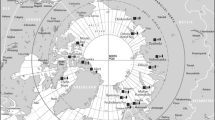Abstract
The Maunder butterfly pattern is the most complete spatial-temporal representation of observed changes in solar activity in the 11-year cycle over a period of 12–24 cycle. The well-known empirical relation is used to transform Greenwich sunspot areas into magnetic flux, and the distances between the butterfly wings are then calculated with the Fisher–Rao metric. We found that the similarities or differences in the patterns of the individual butterfly wings in this metric are approximately the same for each hemisphere. The wings were the closest for a sequence of strong cycles, while there is a tendency for a series of weak cycles to form cycles in pairs with the implementation of an analog of the Gnevyshev–Olya rule.



Similar content being viewed by others
Notes
Density vectorized in this way is called the persistent image.
For the pair of real \({{L}_{2}}\) functions \(f\) and \(g\), this product is defined as \(\left( {f,g} \right) = \int {f\left( x \right)g\left( x \right)dx} .\)
The normalized vector space with the metric (2) is induced by the norm.
That is, each point enters with a weight that determines pdf.
They are sometimes called half densities.
T. expanding the matrix in the row “snake”.
Local diffeomorphism.
REFERENCES
Adams, H., Emerson, T., Kirby, M., et al., Persistence images: a stable vector representation of persistent homology, J. Mach. Learn. Res., 2017, vol. 18, no. 1, pp. 218–252.
Afraimovich, V.S., Ezersky, A.B., Rabinovich, M.I., et al., Dynamical description of spatial disorder, Phys. D (Amsterdam, Neth.), 1992, nos. 1–4, pp. 331–338.
Amari, S., Divergence function, information monotonicity and information geometry, Workshop on Information Theoretic Methods in Science and Engineering (WITMSE), 2009.
Arge, C.N. and Pizzo, V.J., Improvement in the prediction of solar wind conditions using near-real time solar magnetic field updates, J. Geophys. Res.: Space Phys., 2000, no. A5, pp. 10465–10479.
Bazilevskaya, G., Broomhall, A.-M., Elsworth, Y. and Nakariakov, V.M., A combined analysis of the observational aspects of the quasi-biennial oscillation in solar magnetic activity, Space Sci. Rev., 2014, vol. 186, nos. 1–4, pp. 359–386.
Bell, B., On the structure of the sunspot zone, Smithson. Contrib. Astrophys., 1960, vol. 5, no. 3, pp. 17–28.
Cootes, T.F., Twining, C.J., and Taylor, C.J., Diffeomorphic statistical shape models, Proc. British Machine Vision Conference, 2004, vol. 1, pp. 447–456.
Couston, L.A., Lecoanet, D., Favier, B., and Le Bars, M., Order out of chaos: Slowly reversing mean flows emerge from turbulently generated internal waves, Phys. Rev. Lett., 2018, vol. 120, no. 24, 244505.
Covas, E., Spatial-temporal forecasting the sunspot diagram, Astron. Astrophys., 2017, vol. 605, id a44.
Feynman, R., The Feynman Lectures on Physics, New York: Addison Wesley, 1971; Moscow: Mir, 1977, vol. 3, ch. 37–38.
Jost, J. and Jost, J., Riemannian Geometry and Geometric Analysis, Berlin: Springer, 2008.
Karimova, L.M., Kruglun, O.A., Makarenko, N.G., and Romanova, N.V., Power law distribution in statistics of failures in operation of spacecraft onboard equipment, Cosmic Res., 2011, vol. 49, no. 5, pp. 458–463.
Leussu, R., Usoskin, I.G., Pavai, V.S., et al., Wings of the butterfly: Sunspot groups for 1826–2015, Astron. Astrophys., 2017, vol. 599, id A131.
Mininni, P.D., Gómez, D.O., and Mindlin, G.B., Biorthogonal decomposition techniques unveil the nature of the irregularities observed in the solar cycle, Phys. Rev. Lett., 2002, vol. 89, no. 6, 061101.
Rieger, E., Share, G.H., Forrest, D.J., et al., A 154-day periodicity in the occurrence of hard solar flares?, Nature, 1984, vol. 312, no. 5995, pp. 623–625.
Smart, D.F. and Shea, M.A., A simplified model for timing the arrival of solar flare-initiated shocks, J. Geophys. Res.: Space Phys., 1985, vol. 90, no. A1, pp. 183–190.
Srivastava, A. and Klassen, E.P., Functional and Shape Data Analysis, Heidelberg: Springer, 2016.
Ternullo, M., The butterfly diagram internal structure, Astrophys. Space Sci., 2010, nos. 1–2, pp. 301–305.
Tikhomolov, E. and Mordvinov, V., Long-term evolution of the magnetic field generated by an ensemble of Rossby vortices, Astron. Nachr., 2001, no. 3, pp. 189–195.
Tlatov, A.G. and Pevtsov, A.A., Bimodal distribution of magnetic fields and areas of sunspots, Sol. Phys., 2014, vol. 289, no. 4, pp. 1143–1152.
Volobuev, D.M. and Makarenko, N.G., Forecast of the decadal average sunspot number, Sol. Phys., 2008, vol. 249, no. 1, pp. 121–133.
Wang, Z., Bovik, A.C., Sheikh, H.R., et al., Image quality assessment: from error visibility to structural similarity, IEEE Trans. Image Process., 2004, no. 4, pp. 600–612.
Zaqarashvili, T.V., Carbonell, M., Oliver, R., and Ballester, J.L., Quasi-biennial oscillations in the solar tachocline caused by magnetic Rossby wave instabilities, Astrophys. J. Lett., 724(1), L95. 2010.
ACKNOWLEDGMENTS
The authors thank the anonymous reviewer for comments.
Funding
This work was supported by grant AP05134227 (Kazakhstan), and the work of D.M. Volobuev was partially supported by the Russian Foundation for Basic Research (project no. 19-02-00088).
Author information
Authors and Affiliations
Corresponding author
Ethics declarations
The authors declare that they have no conflict of interest.
Rights and permissions
About this article
Cite this article
Volobuev, D.M., Makarenko, N.G. & Knyazeva, I.S. Features of Spatiotemporal Clustering in a Maunder Butterfly Diagram. Geomagn. Aeron. 59, 1036–1041 (2019). https://doi.org/10.1134/S0016793219080255
Received:
Revised:
Accepted:
Published:
Issue Date:
DOI: https://doi.org/10.1134/S0016793219080255




